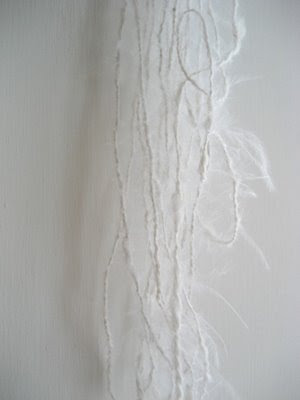 My studio, a veritable jungle of fibers and tools, occasionally reveals a restful moment. Here a beginning tangle drawing, linen canvas, a wool bit and a recent experiment in spinning find themselves in close proximity.
My studio, a veritable jungle of fibers and tools, occasionally reveals a restful moment. Here a beginning tangle drawing, linen canvas, a wool bit and a recent experiment in spinning find themselves in close proximity. 
 This little seductive lock of wool has been around for a long while now, and is one of the early seeds that began my whole thread of work. Above it, hangs something quite new, a yarn of folk legend.
This little seductive lock of wool has been around for a long while now, and is one of the early seeds that began my whole thread of work. Above it, hangs something quite new, a yarn of folk legend.
 Feather and silk handspun together become an artifact of the Crane Wife, an old Japanese tale. The Decemberists first brought this story to me through three songs:
Feather and silk handspun together become an artifact of the Crane Wife, an old Japanese tale. The Decemberists first brought this story to me through three songs:
They tell of a poor man wandering through a snow-covered wood, who comes upon a crane with an arrow in its wing. He removes the shaft and with a grateful bow, the bird flies away. He returns to his humble home and a beautiful woman knocks on his door to ask for shelter. She stay,s and they are soon married. After a time of living in poverty with him, she begins to weave cloth to sell in the marketplace, but she weaves in complete solitude with the express wish that no one looks in on her. The cloth she presents to him to sell is of such exquisite quality that it almost seems to glow and the price her husband receives for it exceeds all expectation.
They live in relative wealth for a time until the day comes when their finances run short and she begins her clandestine weaving again. She finishes and he again sells it, but a local merchant offers to commission yet another bolt of cloth which the young man does not refuse. The young woman appears thin and tired, but returns to her loom once again. The villagers by now begin to wonder about her and tease her husband for letting her weave alone with her secrets. He, being curious himself and reckless from the neighbor's prodding, finally disobeys her and looks in her studio. What he sees causes him to gasp, for at the loom is a beautiful crane, plucking her feathers one by one and weaving them into the cloth. When she realizes his transgression, she gives him a long sorrowful look and flies through the window, never to be seen again.
There are, as with most traditional stories, many variations; in most common variation, the crane becomes the adopted daughter of an elderly childless couple, but it is the tale of the wife with her secret and great skill that I prefer. A proper telling of the story eludes me, most have been diluted through summary retellings or children's versions, and I'd like to find a more detailed or more poetic rendering.
This yarn seems like pure air, when thrown it floats down in a light tangle, and as it does I imagine the cloth the Crane Wife presented to the world. This little bit found a home with a weaver who recently took me under her wing and showed me the way to prepare a loom for my own weaving.

6 comments:
What a lovely story. It reminds me of the Scottish tales of the selkies - seal women who could be enticed to marry if you stole and hid their seal skins. However, when they found their seal skin (as they invariably did), they would always return to the ocean.
kristy, I'm somewhat familiar with the story of the selkies, which is a beautiful, terrifying tale. Thank you for reminding me of it.
your blog is very nice and such a lovely story.
i heard this story as a child - so beautiful and poignant. love it.
thanks for the reminder!
What a beautiful and sad story - your images say it all - I love their simplicity - I lovely post - thank you Sculptress
love the moment of calm :)
and gorgeous story :)
thea.
xx
(www.forthevisionaries.tumblr.com)
Post a Comment